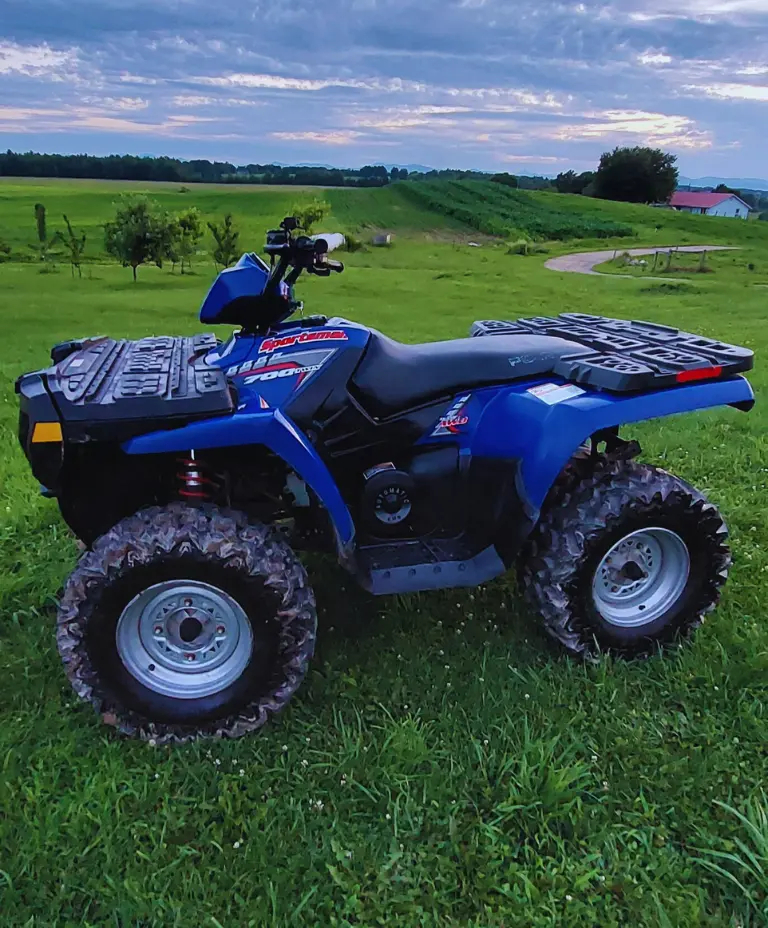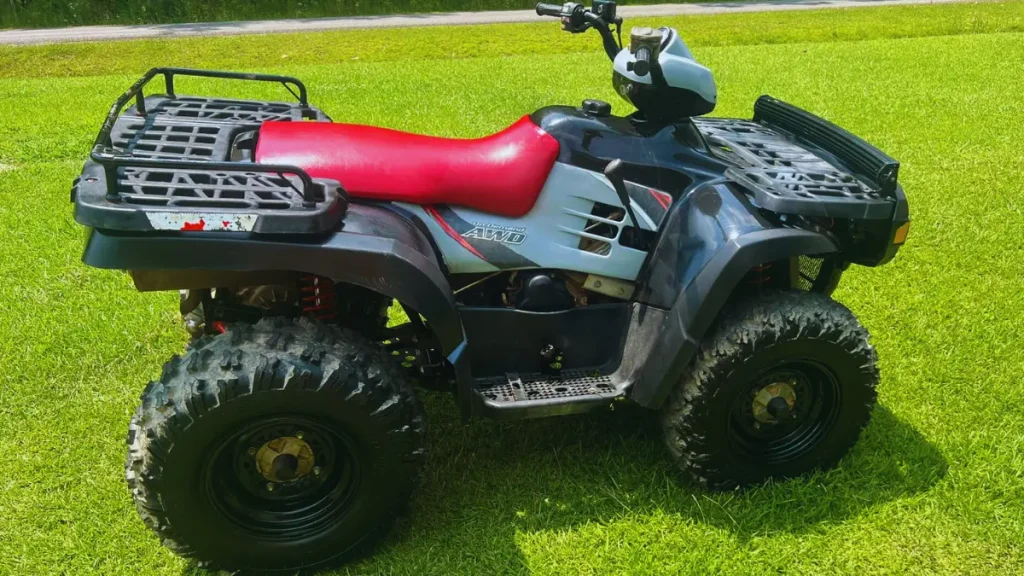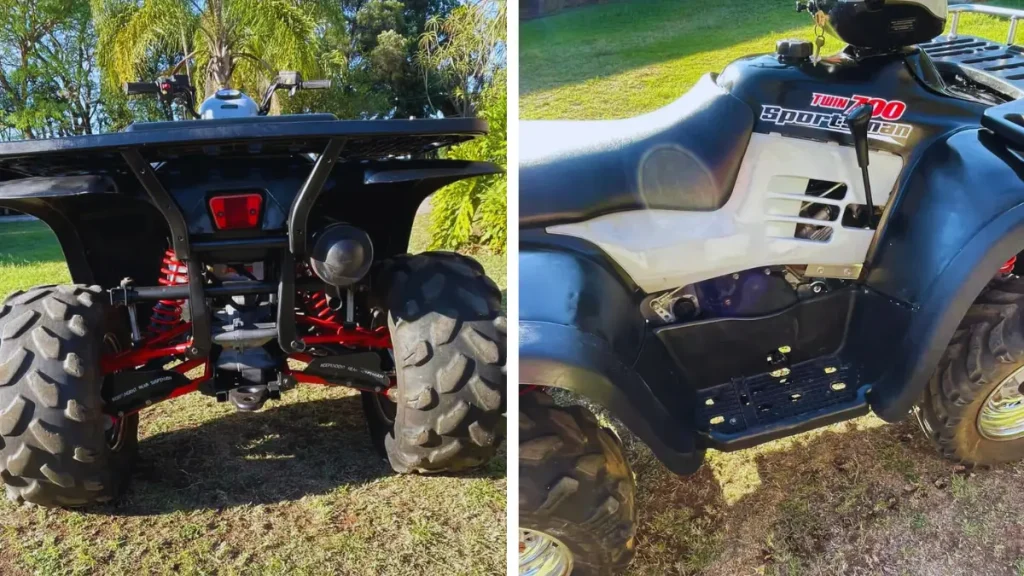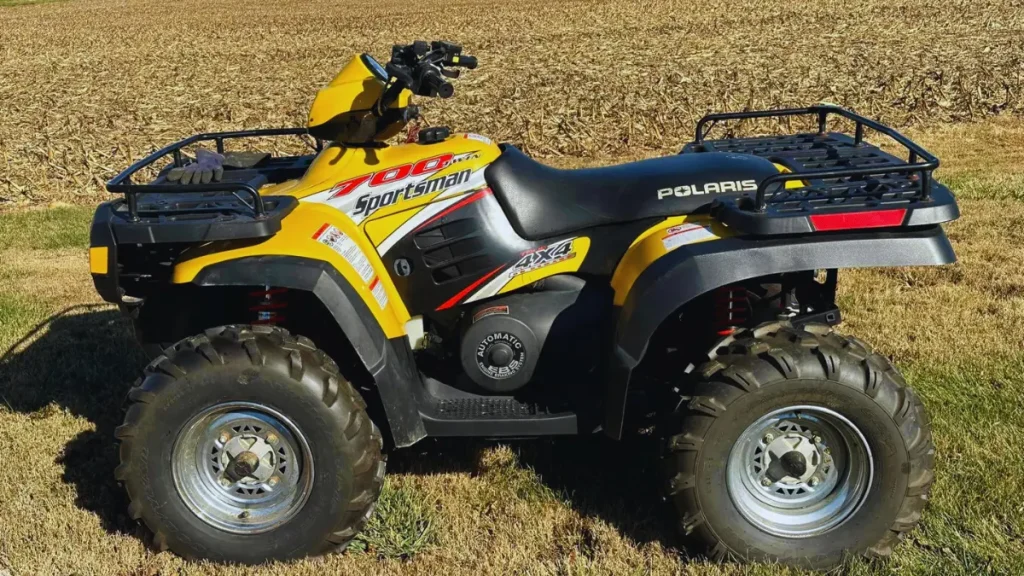Back in the late 90’s, Polaris was doing their best to scratch and claw their way into being recognized as an industry leader in the ATV space.
They made plenty of waves with early classics like the Polaris Magnum 425 and the Polaris Sportsman 500, which really put them on the map.
But they weren’t seen as a true innovator in the industry until the early 2000’s, when their newest ATV model changed the industry for the better forever.
That model was the Polaris Sportsman 700.
This review of the Sportsman 700 will detail what made it so groundbreaking, along with highlighting the good and bad of this model in the following areas:
- Big changes and upgrades this model saw in 2005
- Build quality and performance
- Design and durability
- How fast it can go
- What owners love
- What owners don’t love
Two Firsts For ATVs – About The Sportsman 700
The Sportsman 700 was Polaris’ biggest and most powerful ATV option back in the early 2000s, seeing its production run last from 2002 to 2008.
Not only was it Polaris’ most powerful quad, but it also featured the largest engine displacement of any recreational quad in the industry when it was first introduced.
This model looked like your classic, bulky utility ATV but included modern body styling at the time to give it an appealing look, somewhat similar to the Yamaha Kodiak 700 of today.

It excelled on the trails and in rough terrain, and was a favorite of hunters who needed the ability to make it to backcountry sites and then haul out heavy game across rough terrain.
In their first few years of production up until 2004, every Sportsman made use of a carburetor to provide its fuel delivery.
But Polaris paved the way for electronic fuel injection with this model, making it the first-ever ATV to feature EFI starting in mid-2004 through its final year of production in 2008.
But this wasn’t the only big change these models saw during their heyday.
2005+ Sportsman 700 Changes
Following Polaris’ ground-breaking installation of fuel injection in these models in 2004, more changes followed.
In 2005, the Sportsman 700 models got a styling overhaul along with several notable upgrades that raised their performance levels even higher than that of the 2002-2004 models.
Some of these upgrades were made to help alleviate some of the common Sportsman 700 problems that owners had begun to voice frustration about.
- New, improved, and more modern gauge pod display
- Bigger, more aggressive 26-inch tires
- Longer suspension struts with more travel
- Boxier design and beefier look
- New, more aggressive-looking front bumper
- New storage racks with a storage compartment under front rack
- Replaced the AC-powered ignition with a DC-powered ignition
Build Quality & Performance
Engines
The Sportsman 700 is powered by a 683cc twin-cylinder engine. The standard models get a max output of around 45 HP while the EFI models get slightly more.
The big V-Twin engines in these models provide good low-end power, though when compared with similar engines in the more modern 700 class ATVs they may feel slightly underpowered.

Either way, you’ll have no problem with most mud, sand, snow or steep inclines while riding these.
The early Sportsman 700 models all came equipped with a carburetor, but in 2004 Polaris made the Sportsman 700 the first-ever ATV model to feature electronic fuel injection as they began offering both options.
This was ground-breaking and the new EFI models offered the following:
- No more cold-start issues where the choke needed to be pulled for the engine to start or run
- Smoother, more responsive power
- Automatic adjustment to temperature/altitude changes
- Better fuel economy
One of the drawbacks with the Sportsman 700 was its throttle response, which is slightly delayed when starting from a stop and requires higher revving to get going than is ideal.
The electric ignition offers easy starting with the twist of the ignition on the dash.
| Engine Type | 4 Stroke |
| Cylinder Arrangement | Twin Cylinder |
| Displacement | 683 cc |
| Horsepower | 45 HP (estimated) |
| Engine Cooling | Liquid Cooled |
| Fuel Delivery | Carburetor or EFI (2004+) |
| Fuel Capacity | 4.1 US Gallons |
Drivetrains
The Sportsman 700 features selectable 2WD/4WD via a switch on the handlebar, with the display showing which drive mode you’re in.
A shaft drive powers the wheels, along with a Hilliard-type clutch assembly that minimizes steering effort.
A gear shifter on the right fender enables you to select between both High and Low ranges, along with Neutral, Reverse, and Park settings.
This model is equipped with the Polaris Variable Transmission, which makes for smooth, automatic shifts.
The Reverse setting comes in quite handy on the trails, but this model requires you to use the Reverse override button located on the left handlebar to enable 4WD when in Reverse, which you obviously need if trying to get unstuck.
There’s an engine braking system that does its job but only applies to the rear wheels, which can lead to the rear wheels sliding and skidding out to either side occasionally when heading down steep trails.
| Drive System | 2WD/4WD, Shaft |
| Transmission Type | Polaris Variable Transmission (PVT) |
| Gears | H – L – N – R – P |
Suspensions
This model comes equipped with a Macpherson Strut style suspension (single A-Arm) in front and Dual A-Arms with sway bar in the rear.
In 2005, the suspension got longer struts which increased the front travel from the standard 6.7 inches in older models to 8.2 inches which made the suspension even better at soaking up chop and made the ride that much smoother.

The rear travel remained the same at an impressive 9.5 inches.
The ground clearance on these models is about as solid as you’ll find on an ATV, even today, and lends to its ability to conquer the roughest terrain and rutted trails.
One drawback is a slightly unimpressive turning radius of 6.3 feet for these boxy models.
| Wheelbase | 50.8 in |
| Turning Radius | 6.3 ft |
| Ground Clearance | 11.25 in |
| Front Suspension | Macpherson Strut |
| Rear Suspension | Dual A-Arm w/ Sway Bar |
| Front Travel | 6.7 in (8.2 in 2005+) |
| Rear Travel | 9.5 in |
Tires & Brakes
The Sportsman 700 started out with 25-inch Carlisle Badlands stock tires in the front and rear, but later got an upgrade to bigger 26-inch Carlisle Radial Mud Terrain tires.
The tires were always fine, but the upgrade in 2005 improved traction by that much more on the trails and in loose, irregular terrain and made a big difference for the better in the snow.
Hydraulic disc brakes in the front and rear are controlled by a single brake lever on the handlebar, along with a pedal in the right footwell.
You’ll also need to apply the foot pedal when shifting into certain gears using the gear shift.
Overall the brakes are solid and plenty capable of stopping this model in any terrain and on slick surfaces.
| Front Tires | 25 x 8-12 Carlisle Badlands |
| Front Tires (2005+) | 26 x 8-12 Carlisle Radial MT |
| Rear Tires | 25 x 11-12 Carlisle Badlands |
| Rear Tires (2005+) | 26 x 11-12 Carlisle Radial MT |
| Front Brake Type | Hydraulic Disc |
| Rear Brake Type | Hydraulic Disc |
Dimensions & Capacities
This model has a bulky, boxy build to it with dimensions of 81 inches long, 46 inches wide and 47 inches tall.
That still leaves it capable of riding most trails and tight wooded areas, including BLM land with width restrictions of 50 inches or less.
It weighs in at 740 lbs, which is just slightly heavier than most modern day models in the 700cc class.
This heavier weight combined with its bulky build does make it less agile than comparable models and just a bit harder to handle and control on winding trails.
But as a bigger model with great engine power, it offers an impressive towing capacity of 1,500 lbs and hauling capacity of 300 lbs between the two combined storage racks.
| Length | 81 in |
| Width | 46 in |
| Height | 47 in |
| Seat Height | 34 in |
| Curb Weight | 740 lbs |
| Towing Capacity | 1,500 lbs |
| Rack Capacity | 300 lbs |
Polaris Sportsman 700 Top Speed

The Polaris Sportsman will surprise you with just how fast it is in stock form, able to reach a top speed of just over 70 mph.
In their prime, carbureted models should have been able to hit close to 72 mph. And when the EFI models came along, many owners reported even topping out closer to 75 mph.
All these years later though, a more realistic top speed is somewhere between 63 and 68 mph though, unless you have a unit that’s still in tip-top shape.
Polaris Sportsman 700 Review – What Owners Love
- Front and rear standard storage racks that can haul up to 300 lbs.
- Good-sized under-rack storage compartment up front.
- Body styling and plastics designed to withstand the abuse of hard riding.
- Gauge pod between the handlebars that displays speedometer, odometer, tachometer, fuel gauge, drive mode and gear indicators.
- Reverse override button to give you 4WD and more power if needed while in Reverse.
- Two high/low beam headlights on the front fenders and a pod headlight between the handlebars offer good light for night riding.
- Single rear tail light and brake light.
- These machines excel at slow-speed riding and crawling, both uphill and downhill, thanks to their engine tuning and suspension.
- The seat is very comfortable on your rear end.
- The engine can be started in any gear even without the brakes applied.
Polaris Sportsman 700 Review – What Owners Don’t Love
- The carbureted models are known to have cold-starting issues where they won’t start or run without the choke pulled in cold temps.
- The engine can feel slightly underpowered compared to more modern 700cc ATVs.
- The weight and bulky build of these models makes them harder to handle and less agile than some comparable models.
- Their tall, boxy builds make them a little tippy when cornering at high speeds.
- These models are known to guzzle fuel.
- The lowered location of the air intake leads to some water getting in through shallow puddles or water crossings, so snorkeling is ideal.
- You have to feather the throttle going downhill to engage the engine braking, or else you’ll free roll.
- The engine braking only brakes the rear wheels, which can lead to them sliding out from side to side in steep terrain.
- The gears are prone to grinding when going into Forward from Reverse or Neutral.
- The ignition system in pre-2005 models was an achilles heel of these models and was very prone to failure before it was changed in 2005.
Some of these common issues can be prevented in these older models by simply covering your ATV in between rides.
Which Years To Avoid
The 2002, 2003, and early 2004 models are all going to have a carburetor and make use of the old AC ignition system, assuming it hasn’t gone out on the current owner yet.
If you’re looking at buying a used model, I’d look for a 2005+ EFI model so that you get all of the positive changes Polaris made to these models mentioned towards the start of this guide.
Final Word
Even twenty-ish years later, these models still offer an impressive blend of speed and power for those who want the ability to both work and cut loose with their quad.
For more early Polaris models, check out this review of the Sportsman 335 or this Magnum 330 review before you hit the trails.


